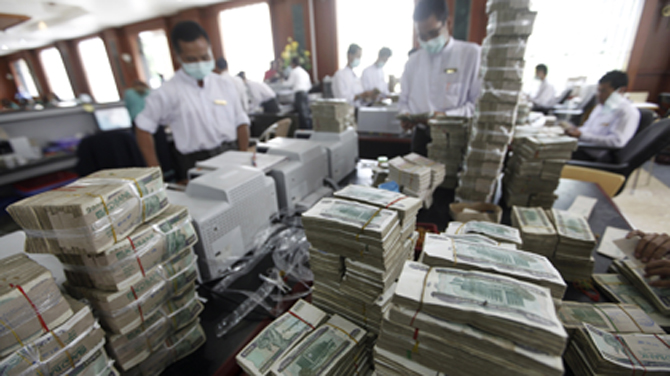The Burmese government is preparing to navigate its greatest economic reform yet—reunifying the kyat and abolishing years of absurd official valuation of the currency, in a move earlier described by Naypyidaw's chief economic adviser U Myint as “essential.”
It is understood that the kyat will initially be floated at 800 to the US dollar. Reuters news agency reported this week that Central Bank Deputy Governor Maung Maung Win stated in a presentation that preparations for the move would be made “by the end of the month”—the beginning of the next financial year.
This would be followed by a gradual “managed floatation” of the currency over the coming year, claimed the report. This would also include 11 private banks being allowed to trade the kyat with US and Singapore dollars and the Euro, thereby seeking to eliminate black market trading in the currency. The Burmese government has long struggled with a limited ability to control the kyat's market value.
The rate of the kyat was described as the “mother of all prices” by U Myint in a presentation on last year's dangerous appreciation which made it the best performing currency in Asia, and therefore caused havoc to local exporters.
The dual currency rate not only made government control of exchange rates difficult, but has also been labeled as the country's most important mechanism for graft. While accounting is done at the official rate, which has been pegged at roughly six to the dollar for over 30 years, commodities such as natural gas are sold on the international market at the more realistic rate of around 800 to the dollar.
This practice results in only 15 billion of over 2,000 billion kyat of gas revenues per year appearing on the books, and therefore being available for regular expenditure. Economist Sean Turnell believes this led Burma to have an “artificial deficit,” as profits were hidden. Analysts assert that much of the hidden money was spent on military capital expenditure—purchasing expensive hardware from international firms.
The situation was also blamed on the aforementioned currency appreciation, as beneficiaries of the graft—such as the military-controlled Union of Myanmar Economic Holdings Limited (UMEHL)—used the money to acquire assets in a government “privatization” drive, and flooded cash back into the country, buying kyat. UMEHL was believed to have acquired the largest share of such assets.
Turnell, whilst welcoming the floating, questioned whether this step would stamp out the culture of dubious accounting. “It is a good move, and consistent with a more rational way of managing the economy,” he said. “The crucial question that extends from it is whether this rate will now apply to all the foreign exchange earnings of state-owned enterprises.
“This later issue is critical to determining Burma's true budgetary and fiscal situation, and therefore how much of the country's resources can be devoted to health, education and so on—and how much is allocated to the military.”
However, the practice is also said to be utilized to supplement the tiny wages of ordinary civil servants. The government recently announced a raise in civil servant wages, perhaps in anticipation of the floatation move which could seriously decrease their income.
The government opened official exchange booths in November last year and, as of Feb. 1, allowed undocumented exchanges of kyat up to US $ 10,000.
Attempts at reform have been made in the past with limited success—this includes the introduction of the Foreign Exchange Certificate which was used as a surrogate currency but was closer to market rates.
The ponderance regarding reform of the currency has also, according to some analysts, been an issue of national pride, with senior military figures viewing a strong kyat as important, even if highly unrealistic.
An International Monetary Fund representative noted following a trip to Burma in January that “reforming the complex exchange rate system is a priority to eliminate constraints on economic growth.”
But the body also warned that a “successful exchange rate unification would require improvements in all areas of macroeconomic management.”

